belt SUZUKI XL7 2007 2.G Owners Manual
[x] Cancel search | Manufacturer: SUZUKI, Model Year: 2007, Model line: XL7, Model: SUZUKI XL7 2007 2.GPages: 274, PDF Size: 6.12 MB
Page 12 of 274

SEATS AND RESTRAINT SYSTEMS
1
78J00-03E
SEATS AND RESTRAINT SYSTEMSFront Seats .......................................................................... 1-1
Rear Seats ............................................................................ 1-6
Safety Belts .......................................................................... 1-9
Child Restraints ................................................................... 1-18
Airbag System ..................................................................... 1-33
Restraint System Check ..................................................... 1-42
Page 15 of 274

1-3 SEATS AND RESTRAINT SYSTEMS
78J00-03E
Driver’s seat with manual recline and
manual height adjuster shown
1618868
To adjust the seatback on the driver’s seat,
lift the lever on the rear outboard side of
the seat and move the seatback to the
desired position. Then release the lever to
lock the seatback in place.Passenger seat with folding seatback
option shown
1618866
To adjust the seatback on the front passen-
ger’s seat, lift the lever on the outboard
side of the seat and move the seatback to
the desired position. Then release the
lever to lock the seatback in place. If your
front passenger’s seat is a flat folding seat,
you must fully raise the lever to disengage
the seatback.
806881
WARNING
Sitting in a reclined position when
your vehicle is in motion can be dan-
gerous. Even if you buckle up, your
safety belts cannot do their job when
you are reclined like this.
The shoulder belt cannot do its job
because it will not be against your
body. Instead, it will be in front of
you. In a crash, you could go into it,
receiving neck or other injuries.
The lap belt cannot do its job either.
In a crash, the belt could go up over
your abdomen. The belt forces would
be there, not at your pelvic bones.
This could cause serious internal
injuries.
(Continued)
Page 16 of 274
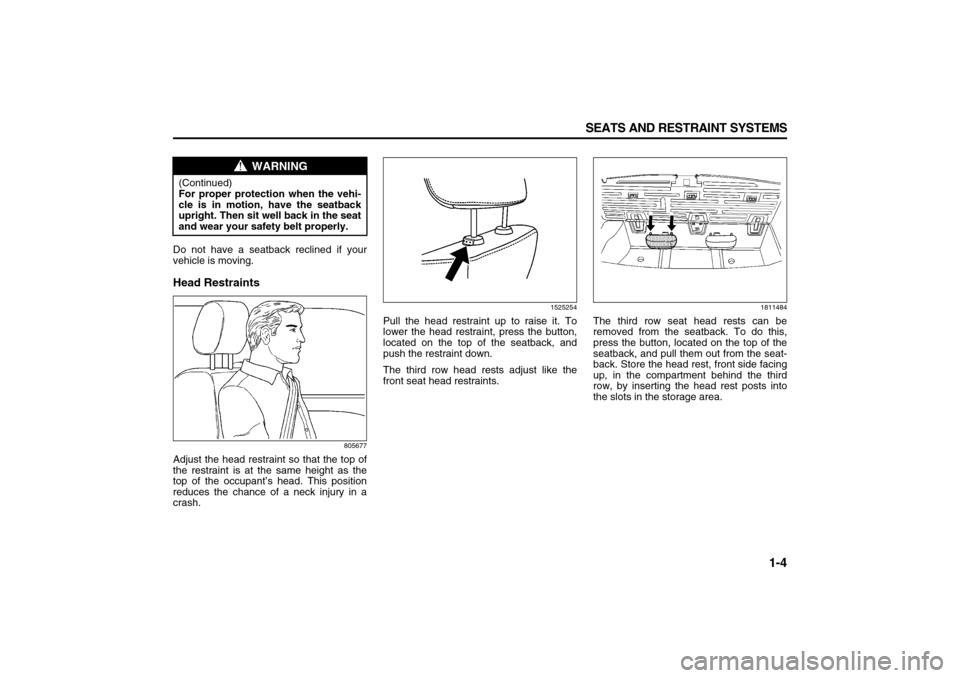
1-4 SEATS AND RESTRAINT SYSTEMS
78J00-03E
Do not have a seatback reclined if your
vehicle is moving. Head Restraints
805677
Adjust the head restraint so that the top of
the restraint is at the same height as the
top of the occupant’s head. This position
reduces the chance of a neck injury in a
crash.
1525254
Pull the head restraint up to raise it. To
lower the head restraint, press the button,
located on the top of the seatback, and
push the restraint down.
The third row head rests adjust like the
front seat head restraints.
1811484
The third row seat head rests can be
removed from the seatback. To do this,
press the button, located on the top of the
seatback, and pull them out from the seat-
back. Store the head rest, front side facing
up, in the compartment behind the third
row, by inserting the head rest posts into
the slots in the storage area.
WARNING
(Continued)
For proper protection when the vehi-
cle is in motion, have the seatback
upright. Then sit well back in the seat
and wear your safety belt properly.
Page 18 of 274
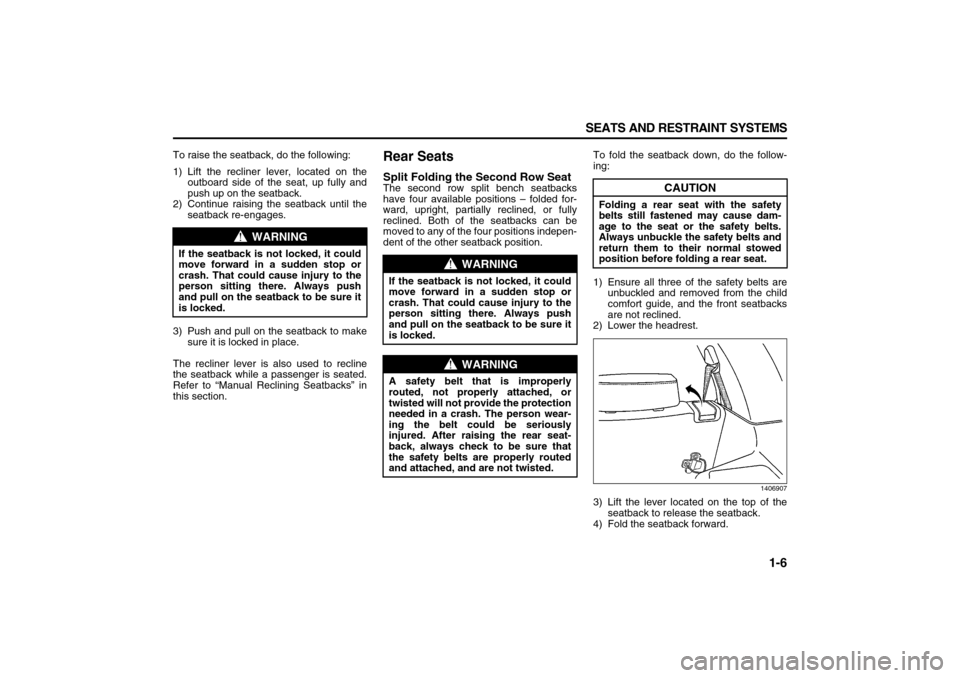
1-6 SEATS AND RESTRAINT SYSTEMS
78J00-03E
To raise the seatback, do the following:
1) Lift the recliner lever, located on the
outboard side of the seat, up fully and
push up on the seatback.
2) Continue raising the seatback until the
seatback re-engages.
3) Push and pull on the seatback to make
sure it is locked in place.
The recliner lever is also used to recline
the seatback while a passenger is seated.
Refer to “Manual Reclining Seatbacks” in
this section.
Rear SeatsSplit Folding the Second Row SeatThe second row split bench seatbacks
have four available positions – folded for-
ward, upright, partially reclined, or fully
reclined. Both of the seatbacks can be
moved to any of the four positions indepen-
dent of the other seatback position. To fold the seatback down, do the follow-
ing:
1) Ensure all three of the safety belts are
unbuckled and removed from the child
comfort guide, and the front seatbacks
are not reclined.
2) Lower the headrest.
1406907
3) Lift the lever located on the top of the
seatback to release the seatback.
4) Fold the seatback forward.
WARNING
If the seatback is not locked, it could
move forward in a sudden stop or
crash. That could cause injury to the
person sitting there. Always push
and pull on the seatback to be sure it
is locked.
WARNING
If the seatback is not locked, it could
move forward in a sudden stop or
crash. That could cause injury to the
person sitting there. Always push
and pull on the seatback to be sure it
is locked.
WARNING
A safety belt that is improperly
routed, not properly attached, or
twisted will not provide the protection
needed in a crash. The person wear-
ing the belt could be seriously
injured. After raising the rear seat-
back, always check to be sure that
the safety belts are properly routed
and attached, and are not twisted.
CAUTION
Folding a rear seat with the safety
belts still fastened may cause dam-
age to the seat or the safety belts.
Always unbuckle the safety belts and
return them to their normal stowed
position before folding a rear seat.
Page 19 of 274
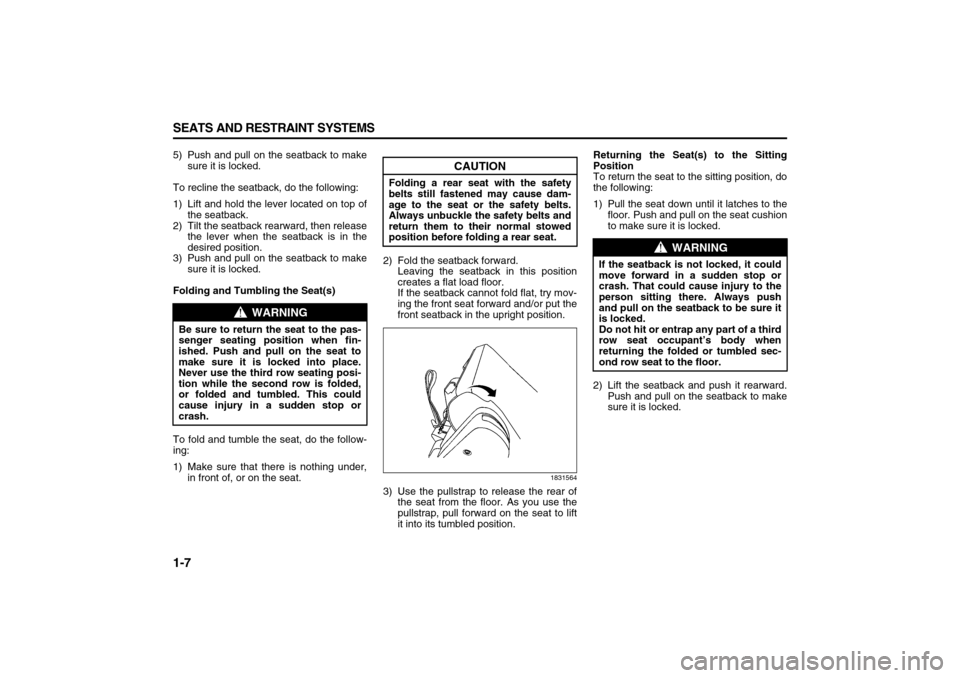
1-7 SEATS AND RESTRAINT SYSTEMS
78J00-03E
5) Push and pull on the seatback to make
sure it is locked.
To recline the seatback, do the following:
1) Lift and hold the lever located on top of
the seatback.
2) Tilt the seatback rearward, then release
the lever when the seatback is in the
desired position.
3) Push and pull on the seatback to make
sure it is locked.
Folding and Tumbling the Seat(s)
To fold and tumble the seat, do the follow-
ing:
1) Make sure that there is nothing under,
in front of, or on the seat.2) Fold the seatback forward.
Leaving the seatback in this position
creates a flat load floor.
If the seatback cannot fold flat, try mov-
ing the front seat forward and/or put the
front seatback in the upright position.
1831564
3) Use the pullstrap to release the rear of
the seat from the floor. As you use the
pullstrap, pull forward on the seat to lift
it into its tumbled position.Returning the Seat(s) to the Sitting
Position
To return the seat to the sitting position, do
the following:
1) Pull the seat down until it latches to the
floor. Push and pull on the seat cushion
to make sure it is locked.
2) Lift the seatback and push it rearward.
Push and pull on the seatback to make
sure it is locked.
WARNING
Be sure to return the seat to the pas-
senger seating position when fin-
ished. Push and pull on the seat to
make sure it is locked into place.
Never use the third row seating posi-
tion while the second row is folded,
or folded and tumbled. This could
cause injury in a sudden stop or
crash.
CAUTION
Folding a rear seat with the safety
belts still fastened may cause dam-
age to the seat or the safety belts.
Always unbuckle the safety belts and
return them to their normal stowed
position before folding a rear seat.
WARNING
If the seatback is not locked, it could
move forward in a sudden stop or
crash. That could cause injury to the
person sitting there. Always push
and pull on the seatback to be sure it
is locked.
Do not hit or entrap any part of a third
row seat occupant’s body when
returning the folded or tumbled sec-
ond row seat to the floor.
Page 20 of 274
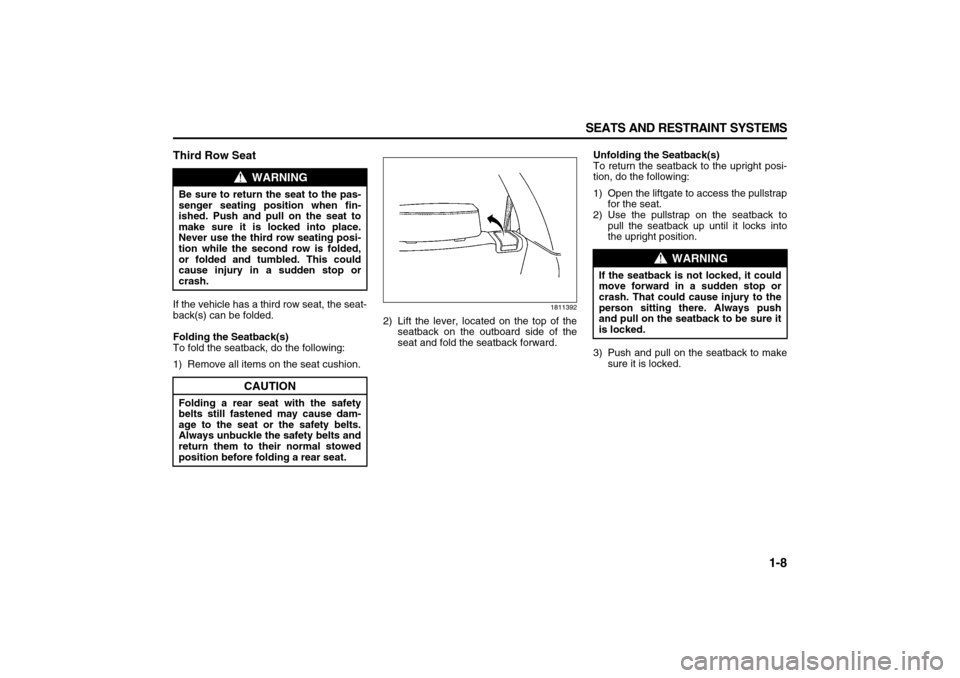
1-8 SEATS AND RESTRAINT SYSTEMS
78J00-03E
Third Row SeatIf the vehicle has a third row seat, the seat-
back(s) can be folded.
Folding the Seatback(s)
To fold the seatback, do the following:
1) Remove all items on the seat cushion.
1811392
2) Lift the lever, located on the top of the
seatback on the outboard side of the
seat and fold the seatback forward.Unfolding the Seatback(s)
To return the seatback to the upright posi-
tion, do the following:
1) Open the liftgate to access the pullstrap
for the seat.
2) Use the pullstrap on the seatback to
pull the seatback up until it locks into
the upright position.
3) Push and pull on the seatback to make
sure it is locked.
WARNING
Be sure to return the seat to the pas-
senger seating position when fin-
ished. Push and pull on the seat to
make sure it is locked into place.
Never use the third row seating posi-
tion while the second row is folded,
or folded and tumbled. This could
cause injury in a sudden stop or
crash.
CAUTION
Folding a rear seat with the safety
belts still fastened may cause dam-
age to the seat or the safety belts.
Always unbuckle the safety belts and
return them to their normal stowed
position before folding a rear seat.
WARNING
If the seatback is not locked, it could
move forward in a sudden stop or
crash. That could cause injury to the
person sitting there. Always push
and pull on the seatback to be sure it
is locked.
Page 21 of 274

1-9 SEATS AND RESTRAINT SYSTEMS
78J00-03E
Safety BeltsSafety Belts: They Are for EveryoneThis part of the manual tells you how to
use safety belts properly. It also tells you
some things you should not do with safety
belts.Your vehicle has indicators to remind you
and your passengers to buckle your safety
belts. Refer to “Safety Belt Reminder Light”
and “Passenger Safety Belt Reminder
Light” in “Warning Lights, Gages, and Indi-
cators” in the “Instrument Panel” section.
In most states and in all Canadian prov-
inces, the law says to wear safety belts.
Here is why: They work.
You never know if you will be in a crash. If
you do have a crash, you do not know if it
will be a bad one.
A few crashes are mild, and some crashes
can be so serious that even buckled up, a
person would not survive. But most
crashes are in between. In many of them,
people who buckle up can survive and
sometimes walk away. Without belts they
could have been badly hurt or killed.
After more than 40 years of safety belts in
vehicles, the facts are clear. In most
crashes buckling up does matter ... a lot!
Why Safety Belts Work
When you ride in or on anything, you go as
fast as it goes.
806079
Take the simplest vehicle. Suppose it is
just a seat on wheels.
805926
Put someone on it.
WARNING
Do not let anyone ride where he or
she cannot wear a safety belt prop-
erly. If you are in a crash and you are
not wearing a safety belt, your inju-
ries can be much worse. You can hit
things inside the vehicle or be
ejected from it. You can be seriously
injured or killed. In the same crash,
you might not be, if you are buckled
up. Always fasten your safety belt,
and check that your passengers’
belts are fastened properly too.
WARNING
It is extremely dangerous to ride in a
cargo area, inside or outside of a
vehicle. In a collision, people riding
in these areas are more likely to be
seriously injured or killed. Do not
allow people to ride in any area of
your vehicle that is not equipped with
seats and safety belts. Be sure every-
one in your vehicle is in a seat and
using a safety belt properly.
Page 22 of 274

1-10 SEATS AND RESTRAINT SYSTEMS
78J00-03E
805928
Get it up to speed. Then stop the vehicle.
The rider does not stop.
805931
The person keeps going until stopped by
something. In a real vehicle, it could be the
windshield...
809245
or the instrument panel...
805935
or the safety belts!
With safety belts, you slow down as the
vehicle does. You get more time to stop.
You stop over more distance, and yourstrongest bones take the forces. That is
why safety belts make such good sense.
Questions and Answers About
Safety BeltsQuestion:
Will I be trapped in the vehicle after an
accident if I am wearing a safety belt?
Answer:
You could be – whether you are wearing a
safety belt or not. But you can unbuckle a
safety belt, even if you are upside down.
And your chance of being conscious dur-
ing and after an accident, so you can
unbuckle and get out, is much greater if
you are belted.
Question:
If my vehicle has airbags, why should I
have to wear safety belts?
Answer:
Airbags are supplemental systems only; so
they work with safety belts – not instead of
them. Every airbag system ever offered for
sale has required the use of safety belts.
Even if you are in a vehicle that has air-
bags, you still have to buckle up to get the
most protection. That is true not only in
frontal collisions, but especially in side and
other collisions.
Page 23 of 274
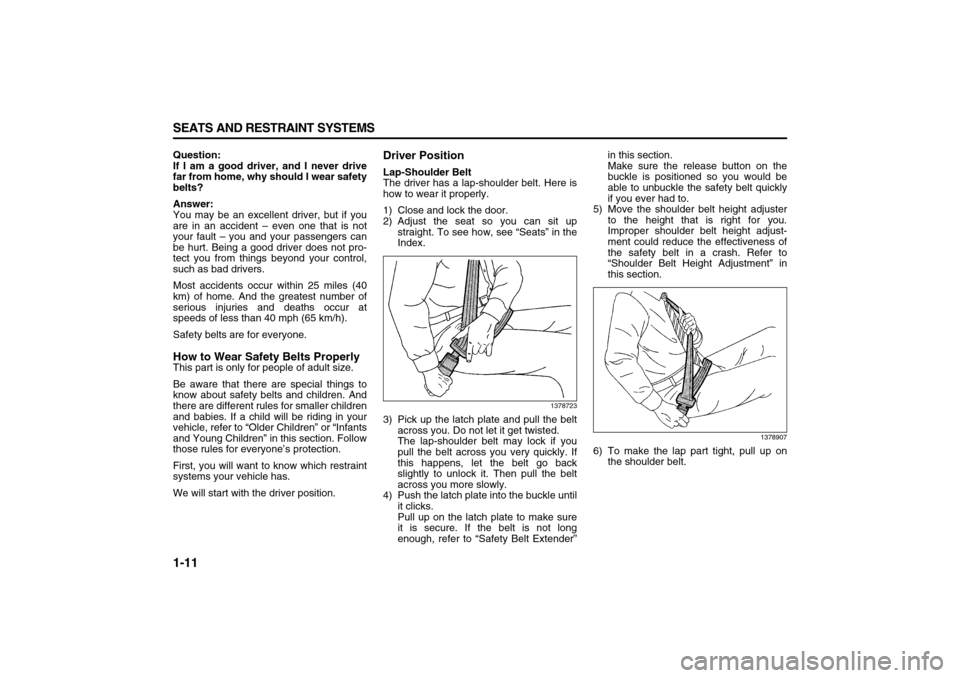
1-11 SEATS AND RESTRAINT SYSTEMS
78J00-03E
Question:
If I am a good driver, and I never drive
far from home, why should I wear safety
belts?
Answer:
You may be an excellent driver, but if you
are in an accident – even one that is not
your fault – you and your passengers can
be hurt. Being a good driver does not pro-
tect you from things beyond your control,
such as bad drivers.
Most accidents occur within 25 miles (40
km) of home. And the greatest number of
serious injuries and deaths occur at
speeds of less than 40 mph (65 km/h).
Safety belts are for everyone.How to Wear Safety Belts ProperlyThis part is only for people of adult size.
Be aware that there are special things to
know about safety belts and children. And
there are different rules for smaller children
and babies. If a child will be riding in your
vehicle, refer to “Older Children” or “Infants
and Young Children” in this section. Follow
those rules for everyone’s protection.
First, you will want to know which restraint
systems your vehicle has.
We will start with the driver position.
Driver PositionLap-Shoulder Belt
The driver has a lap-shoulder belt. Here is
how to wear it properly.
1) Close and lock the door.
2) Adjust the seat so you can sit up
straight. To see how, see “Seats” in the
Index.
1378723
3) Pick up the latch plate and pull the belt
across you. Do not let it get twisted.
The lap-shoulder belt may lock if you
pull the belt across you very quickly. If
this happens, let the belt go back
slightly to unlock it. Then pull the belt
across you more slowly.
4) Push the latch plate into the buckle until
it clicks.
Pull up on the latch plate to make sure
it is secure. If the belt is not long
enough, refer to “Safety Belt Extender”in this section.
Make sure the release button on the
buckle is positioned so you would be
able to unbuckle the safety belt quickly
if you ever had to.
5) Move the shoulder belt height adjuster
to the height that is right for you.
Improper shoulder belt height adjust-
ment could reduce the effectiveness of
the safety belt in a crash. Refer to
“Shoulder Belt Height Adjustment” in
this section.
1378907
6) To make the lap part tight, pull up on
the shoulder belt.
Page 24 of 274
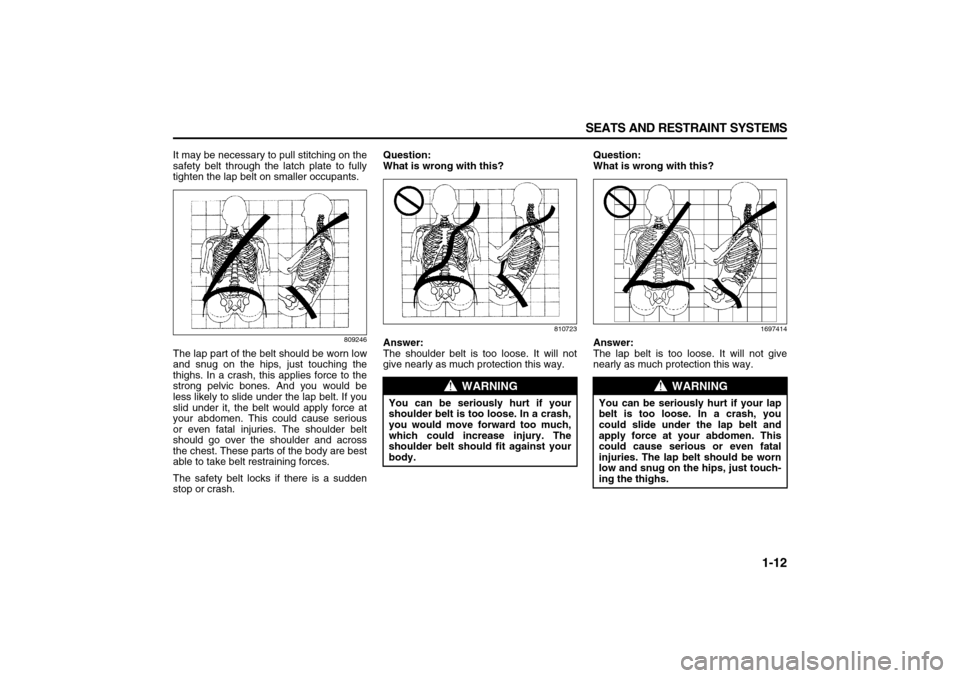
1-12 SEATS AND RESTRAINT SYSTEMS
78J00-03E
It may be necessary to pull stitching on the
safety belt through the latch plate to fully
tighten the lap belt on smaller occupants.
809246
The lap part of the belt should be worn low
and snug on the hips, just touching the
thighs. In a crash, this applies force to the
strong pelvic bones. And you would be
less likely to slide under the lap belt. If you
slid under it, the belt would apply force at
your abdomen. This could cause serious
or even fatal injuries. The shoulder belt
should go over the shoulder and across
the chest. These parts of the body are best
able to take belt restraining forces.
The safety belt locks if there is a sudden
stop or crash.Question:
What is wrong with this?
810723
Answer:
The shoulder belt is too loose. It will not
give nearly as much protection this way.Question:
What is wrong with this?
1697414
Answer:
The lap belt is too loose. It will not give
nearly as much protection this way.
WARNING
You can be seriously hurt if your
shoulder belt is too loose. In a crash,
you would move forward too much,
which could increase injury. The
shoulder belt should fit against your
body.
WARNING
You can be seriously hurt if your lap
belt is too loose. In a crash, you
could slide under the lap belt and
apply force at your abdomen. This
could cause serious or even fatal
injuries. The lap belt should be worn
low and snug on the hips, just touch-
ing the thighs.